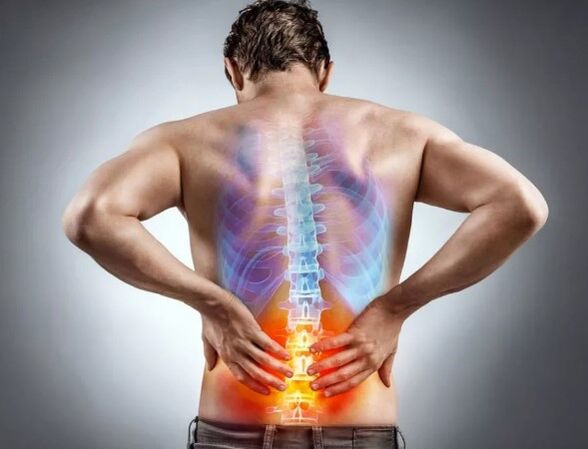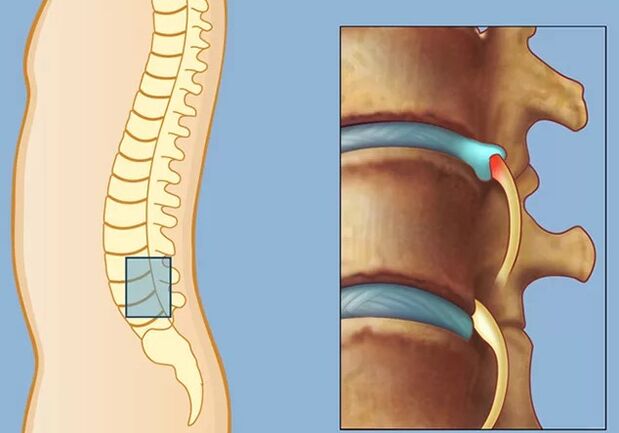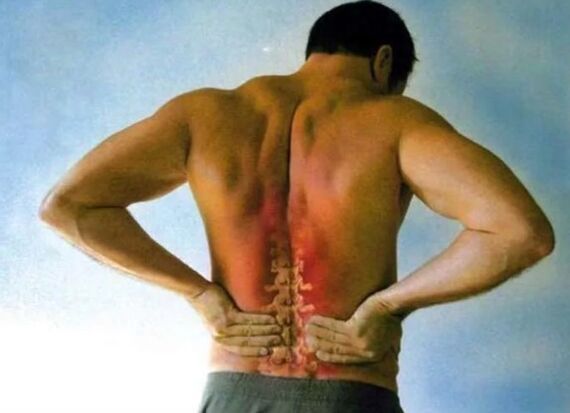Osteochondrosis of the lumbar spine is an illness that is a special form of damage to the spine. Patients with such a disease complain about rapid tiredness, back pain and legs, which leads to restrictive motor activity. With osteochondrosis there is a deformation of the intervertebral discs, the growth of vertebrae is accepted. When diagnosing X -rays, the postponement are clearly visible.

The deformation of the cartilaginous tissue during the development of osteochondrosis is a complex process, including biochemical and vascular changes. First, the fibrous ring is destroyed, with the pulse pouter being inserted into it. As a result, the fibrous ring is torn and the hernia of the disc is formed. In this case, the segment with a lower shin and lower liver is exposed to the highest load. The hernia of the disc that presses the spinal cord or its roots becomes the cause of back pain that react in the leg.
The most powerful sciatic nerve in the human body is formed by sacred roots of the spinal cord. They are and the lower lover with osteochondrosis. From the Latin name of the sciatic nerve, the second name of the disease was formed - Ishias.
Due to the violation of the structure of the cartilage tissue, the intervertebral windows, which are special cartilage structures, can no longer fully perform all of their functions. This leads to the loss of flexibility and mobility of the spine. The processes that only influence the intervertebral discs in the early stages of the disease is gradually applying to the vertebrae itself.
Discogened radicolith, which is considered one of the most common symptoms of osteochondrosis, can be found in almost all fifth person who are older than 30 years in the world. There is a risk that people of working age are most often at risk. Osteochondrosis eludes the ability to exercise active activity and often causes disability.
Symptoms of lumbar osteochondrosis
The main symptoms of lumbar osteochondrosis are severe back pain. In addition to this character, there are a number of others. Patients who suffer from this disease are quickly tired and complain about headache, tiredness and irritability. The discomfort in the back does not allow you to choose a comfortable position for sleep, so that the body does not relax and recover after the end of the day. The loss of strength forces patients to minimize physical activity and avoid pain. As a result, he is unable to perform simple acts over time, for example to meet his own budget needs.

Problems in the work of the Genitourary system can also be one of the symptoms of lumbar osteochondrosis. They appear in the form of pain in the kidney area. Urinating is disturbed in patients with osteochondrosis, and the unexpected occurrence of caused symptoms is possible. This leads to the instability of the vertebrae, which are not fixed by intervertebral discs due to a deformation. The load of the spine is aimed at the expulsion of the lumbar department from the sacrum when the severity of the force is exposed to it. Such a process leads to damage to the internal organs, problems in their work. In women, ovaries, attachments and uterus suffer the most often, and the effectiveness is disturbed in men.
Osteochondrosis is characterized by an increase in the sensitivity of the legs, including stop, hips and lower legs. They are cramps that can lead to a full loss of the pulse. The patient's skin with osteochondrosis on the legs is very dry, peeling and with goose bumps in the area of the symptoms. Sweating is disturbed during pain.
All symptoms of osteochondrosis can be divided into the following groups:
Rook syndrome
The thinning of the intervertebral discs leads to the loss of the stability rooms. After they have become mobile, they are annoyed and press blood vessels and nerve roots with sharp movements and severe physical exertion. This process minimizes the pain in the lumbar industry, but they resume with a new force where the nerve is compressed. The pain is acute and drilled. The most uncomfortable is expressed in the lower leg, in the thigh, in the foot and in the buttocks. Unpleasant sensations let the patient change the passage and lean into the opposite side of the nerve.
When the nerve roots are irritated for a long time, their inflammation, swelling, venous stagnation and poisoning occur. The pain applies to muscles, ligaments. It is the most acute in moments of physical activity, especially if it is carried out without warm ups immediately after sleep or a resting state. The pain is often accompanied by an elevated sweating, which replaces the feeling of chills.
The manifestations of the radicular syndrome also include tingling, numbness and loss of sensitivity. The muscles lose their tone so that the patients are unable to endure long -term physical activity, for example, go down and raise the stairs, quickly get tired. The functions of the pelvis are disturbed in particularly serious cases. In this case, the appearance of paralysis and parese is even possible.
Ischemic syndrome
Near nerve roots are blood vessels that are compressed during the deformation. In the first stages of the development of osteochondrosis, the arteries are regularly pressed, but then a cramp receives a constant character. In this case, a "selective lome" occurs, the patient often has to stop and rest with a long time.
Closing blood vessels means that the pelvic organs do not receive the necessary nutrients. This leads to pain on the inside of the hips, perineum, in the buttocks to its paralysis.
Vertack syndrome

Under the influence of pain, ischemic and radicular syndrome, the patient's skeleton is deformed with osteochondrosis. One person begins to bend down, he has a pelvis and a spine that weaken muscles, atrophy. All of these changes influence the course that is adapted depending on the pain area, tense and uncertain. The entire musculoskeletal system of osteochondrosis is gradually exposed to, and the intervertebral discs of the intermediate collapse continues.
Pain syndrome (pain with lumbar osteochondrosis)
Unpleasant sensations and symptoms in the back are the main symptoms for osteochondrosis. The type and strength of pain changes depending on the stage of the development of the disease.
First of all, at the time of the increased voltage of the joints, muscles and ligaments, it can only be felt in the lumbar cone region, i. e. when carrying out physical exertion. It can be constantly. But with the development of osteochondrosis, acute pain or shift even when sneezing occurs.
With the palpation, you can usually determine the seal in the muscles. A pain attack can take several days, and the patient has to watch the bed rest all the time to minimize unpleasant sensations in the back. All sharp movements, weight lifting explosion lead to discomfort.
Causes of lumbar osteochondrosis
The following main reasons for the development of lumbar osteochondrosis are differentiated:
- Uneven load on the spine. According to experts, osteochondrosis is characteristic of a person as a biological species, since it is mainly due to his way of life and directness. The need to maintain the position of the body in a certain position requires a constant tension of the musculoskeletal system. The optimal load on the spine is in a standing position. In a lying position on the back it is minimal, by the way - a little more. In a seated position, however, the load on the lumbar spine increases significantly. The body's inclination creates an additional voltage for the front edge of the vertebrae and the spine. It is therefore recommended to change the position of the body regularly, to relax the muscles and to move the load on the spine and keep your back straight.
- Hypodynamics. A sitting lifestyle, the use of a car and public transport that spends a lot of time for a computer and a television - all of this contributes to the development of problems with the spine, including osteochondrosis. Motor activity lacks a significant part of the population. A passive lifestyle means that the musculoskeletal system weakens. The spine is exposed to a maximum load in a seated position, this becomes the cause of the deformation of cartilage tissue and as a result of the lumbar economy osteochondrosis. Therefore, it is so important to get up regularly and carry out a number of exercises. When a person spends a significant part of the time in a curved position, the bending muscles stretch and lose their tone.
- Too high physical activity. An increased motor activity, like the disadvantage, can also cause osteochondrosis. Back pain is often concerned about athletes who deal with severe athletics. This sport requires weight lifting, which creates additional tensions for the rear muscles and causes hernias to form between vertebral levels.
- Wrong attitude. In the curved position of the spine, the load is unevenly distributed, and this leads to a deformation of the intervertebral discs. The same influence is influenced by improper walking. People and older people run the risk group, since over time the intervertebral discs become less elastic, lose their mobility and are more easily damaged.
- Defects of the bone system and genetic predisposition, injuries and infectious diseases. Osteochondrosis usually causes innate problems with the musculoskeletal system. In addition, the cause of the disease can be the natural fragility of the cartilage. Osteochondrosis also develops as a complication after various damage to the spine, osteomyelitis, tuberculosis.
- Flat feet. In patients who suffer from flat feet, the foot set does not carry out the depreciation functions as in normal condition. During the movement, the entire load is recorded on the intervertebral discs, whereby their faster wear occurs.
- Obesity. Additional kilograms are a source for additional stress for the heart and the bone muscle system, including the spine. According to statistics, people with overweight are more susceptible to different diseases.
- Inflammatory processes in the body. The development of osteochondrosis is caused by factors such as hormonal changes, problems with the joints of the spine, e. g. B. rheumatoid arthritis, disturbed endocrine, digestive and cardiovascular system facilitates.
- Life. Many patients do not pay attention to their health: they move little, don't get enough sleep, eat wrong. This leads to increased fatigue, violation of the psychoemotional state, stress. All of this makes the body very susceptible and contributes to the development of a lumbar osteochondrosis.

Osteochondrosis of the lumbar spine
There is 4 degrees osteochondrosis of the lumbar spine:
- Cracks appear in the fibrous ring, which are filled with a substance from the jet core that causes irritation. At this stage, the deformation of the intervertebral discs is poorly expressed and manifests itself in the form of reflex bok symptoms. The patient can complain about pain in the heart of the lower back. In the back of the cause of the discomfort, sharp movements become weightlifting. Depending on the character, 2 types of pain are differentiated: Lumbalia and Lumbago. In the first case it is stable and suddenly occurs in the second;
- The destruction of the fibrous ring continues. However, the gap between the vertebrae is reducing the nerve end. At this stage, a phenomenon is characteristic of the lumbar region as a pseudo -pondylolist thesis. This is the name of the shift process of the vertebrae in relation to each other, which leads to the clamping of the nerve endings and causes pain. The spine is characterized by unusual mobility. With osteochondose of the 2nd degree, the patients complain about pronounced complaints in the back, in the lumbar area, heat and cold can be felt alternately. The pain manifests itself in seizures where goose bumps occur on the skin and intensified intensification.
- The fibrous ring is finally torn and the jacket kernel is pressed outside. Intertevertebral hernia appears. Pressing the core into the area of the vertebral canal means that the vessels and roots of the spinal nerves are pressed.
The deformation of the spine is formed by lordosis, kyphosis or scoliosis. The spine is converted forward with lordosis. Such a violation of its normal position makes it difficult to work internal organs and its systems. In kyphosis, the upper spine is curved, and in advanced cases there is a feeling of bending. The lateral curvature is shown in the form of scoliosis. If a patient who suffers from osteochondrosis leans forward with such a curvature of the spine, the asymmetry becomes noticeable thanks to the protruding blade or rib;
- The last stage of osteochondrosis is the most dangerous, since the spine is finally deformed, which makes full motor activity impossible. Bone growth in the X -ray image is noticeable. Although the pain does not bother the patient for some time, this does not indicate any improvement. 4 degrees of osteochondrosis ends most often with disabilities.








































